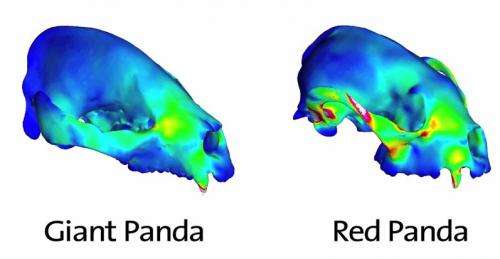Skulls of red and giant pandas provide insight into coexistence

New research on the skulls of red pandas and giant pandas provides further explanation as to why the two species—which are not closely related but dine on the same food, bamboo, in the same geographic area—are able to coexist. Using high-resolution imaging and biting simulations, scientists at the American Museum of Natural History and the University of Málaga in Spain found that the skulls of the two panda species not only are distantly related but also have structural differences related to the way the animals chew. These substantial differences reflect distinct bamboo feeding preferences, with red pandas foraging on softer parts of the plant and giant pandas seeking out the tougher stems. The findings are published in the journal Biology Letters.
"Scientists have been studying the differences between red pandas and giant pandas for a long time because there's a basic principle in ecology that says if two species of an organism utilize the same resources, they cannot live in the same space. There's too much competition," said Z. Jack Tseng, a Frick Postdoctoral Fellow in the Museum's Division of Paleontology and the corresponding author on the new study. "This research contributes to the body of work showing how the pandas co-exist. We've found that fundamentally, based on the structure of their skulls, they cannot eat the same things."
The red (Ailurus fulgens) and giant (Ailuropoda melanoleuca) pandas are mammalian carnivores separated from each other by about 40 million years of evolution. The red panda is most closely related to animals like raccoons and weasels and weighs about 10 pounds. The giant panda is a member of the bear family, and it is much larger, weighing about 220 pounds. Their geographic ranges overlap in southern China, and both animals have independently adapted to a diet consisting mainly of the same bamboo species.
The researchers used x-ray computed tomography (CT) to create high-resolution, three-dimensional models of the pandas' skulls and teeth. Based on these data, they built a series of computer-generated biting simulations to study the skulls' biomechanics. They found that although the skulls have some broad similarities—they both are robust and versatile and can accommodate a wide variety of chewing—there are some distinct differences.
The skull of the red panda is better at distributing mechanical stress during chewing than the skull of the giant panda. But the giant panda has a stronger skull that can withstand greater forces that are more concentrated and could be more damaging, even after accounting for the size differences between the two species.
"These differences tie into the way that the species actually process bamboo," Tseng said. "The giant panda is a less-refined eater: it does a lot of chomping and swallowing. Their skulls are stronger overall, so the peak biting stresses are lower, meaning that they can eat harder and larger pieces of bamboo. The red panda has a weaker skull but it's better at distributing stresses, allowing it to chew longer and break down soft bamboo leaves more thoroughly before they swallow them."
These links between dietary preference and skull performance provide an engineering basis for explaining how the co-existence of the two panda species is possible, the authors say.
More information: rsbl.royalsocietypublishing.or … t/10/4/20140196.full
Journal information: Biology Letters
Provided by American Museum of Natural History



















